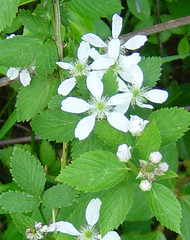It's never a bad idea to stop thinking about whatever is bothering you and think about flowers.
Blackberries are members of the rose family. There are several species of blackberry, and I have no idea which one this is. Roses generally have petals in multiples of five, which are not attached to each other, hence can fall separately. In the picture above, you can see these petals. Several plants that bear fruit that we eat are members of this family, including strawberries, peaches, and apples. Roses are also members of the family, of course. The rose family is one of the largest families of plants.
Blackberries have aggregate fruits, called drupelets. That is, each of the little globes on a blackberry fruit is actually a separate fruit. Drupes have a hard seed in the center, and a fleshy outside, which is good to eat. The seed of blackberries is small enough that it can be ignored, unless it gets stuck in one's teeth. You shouldn't ignore the seed of apricots, peaches, and plums, which are also drupes. Raspberries have drupelets.
Blackberries, in South Carolina and Wisconsin, anyway (places I am most familiar with) often grow in abandoned fields after a year or two since the last cultivation, or along roadsides. They are a part of ecological succession, a fairly early stage thereof. They generally won't grow year after year in the same place, if that place is undisturbed. Since roadsides are disturbed, by mowing, blackberries will grow in the same place year after year.
Blackberries have thorns on their stems, or brambles, which can hurt. The fruit is usually good enough that they are worth picking, in spite of the thorns, although not many people pick. It's usually hot, with pesky insects, always scratchy, and the berries growing near roads are probably polluted. However, I sometimes get a picking or two.
It looks like a good blackberry crop in upstate South Carolina this year. There are blackberry plants in bloom all over the place.



1 comment:
I do have to bring to light the fact that I knew exactly what you were talking about in your blog when you mentioned drupes and leaves in multiples of five (aka dicots). I must say that I had a wonderful Botany teacher.
Post a Comment